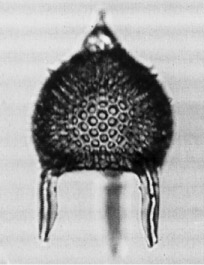 Lychnocanoma
bellum (Clark and Campbell)
Lychnocanoma
bellum (Clark and Campbell) Lychnocanoma
bellum (Clark and Campbell)
Lychnocanoma
bellum (Clark and Campbell)Lychnocanium bellum Clark and Campbell, 1942, p.72, pl.9, figs.35, 39; Riedel and Sanfilippo, 1970, p.529, pl.10, fig.5; Riedel and Sanfilippo, 1971, p.1595
Lychnocanoma bellum (Clark and Campbell), Foreman, 1973, p.437, pl.1, fig.17, pl.11, fig.9
Shell broadly conical, trim, and with sharp collar stricture; apical horn, short, conical, base as wide as length; cephalis subhemispherical, very short (not over 0.3 length of shell), generally slightly asymmetrical with swollen sides, its basal diameter greater than its altitude, collar distinctly set off from thorax below it; thorax dome-shaped with greatly swollen sides, its greatest diameter reached at or near its middle, symmetrical, and very neat and trim; legs three, equal, equidistant, strong, divergent, curved inwardly and hollowed out... with expanded bases; wall relatively thick, uniform, with depressed areas whose elevated edges appear in edge view as surface projections; surface of apical horn, hyaline; of cephalis, without pores; of thorax, with numerous well-spaced, subcircular, elongate-oval, squarish or even subhexagonal pores, these pores double-contoured, generally uniform in size except for a very few, odd scattered small ones; framework around the aperture not dense and connecting the bases of the feet with a narrow, hyaline collar with a basal row of reticulations at the thoracic margin (Clark and Campbell, 1942).
In addition the collar stricture has four collar pores internally, and occasional specimens possess fragments of a partially developed third segment between the feet (Foreman, 1973).
Length of shell 150 µm; of horn 10 µm; of cephalis 21 µm; breadth of base of cephalis 32 µm; maximum of thorax 140 µm; diameter of pores 8.8 µm (Clark and Campbell, 1942).
The hollow legs of this species are unique.
This species is found in both low and middle latitudes and possibly extends even into high latitudes. Its morphotypic first appearance is approximately synchronous with the boundary between the Buryella clinata and Phormocyrtis striata striata Zones. Its morphotypic last appearance is approximately synchronous with the lower limit of the Cryptocarpium ornatum Zone.